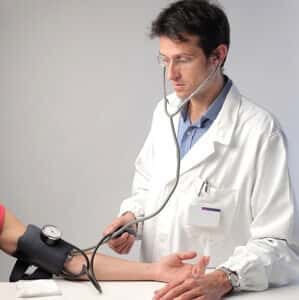
Q. I frequently see medical personnel in their scrubs with their stethoscopes around their necks in the hospital cafeteria or even nearby restaurants. I wonder how often they sanitize those stethoscopes. They seem oblivious to the possibility that they might be spreading germs.
A. Hospitals have been working hard to control infections by encouraging health care workers to wash their hands between patients. In many institutions these efforts have resulted in higher rates of hand washing and lower rates of infection.
Stethoscopes are another matter. Recent research has shown that stethoscopes used to examine patients are as contaminated as the doctor’s hands by the end of the exam (Mayo Clinic Proceedings, March, 2014).
The investigators note that 70 to 90 percent of physicians “do not disinfect systematically their stethoscope after every patient contact.” The lead author, Didier Pittet, MD, MS, says that stethoscopes should be disinfected between patients to avoid spreading dangerous bacteria. Just as patients are being encouraged to ask about hand washing, they might also request that the stethoscope be cleaned before it is used on their skin.
We have written about healthcare-acquired infections and the serious threat they pose to hospitalized individuals in our book, Top Screwups Doctors Make and How to Avoid Them. Although no one wants to imagine that they could be at risk, it makes sense to check out our top tips for staying safe before a loved one needs to go into the hospital or nursing home. Even a routine visit to your doctor’s office could pose problems.
When was the last time you saw the nurse, physician’s assistant or doctor actually take time to clean a stethoscope with an alcohol wipe? Would you have the nerve to request that they disinfect the bell of the stethoscope before listening to your heart or lungs? We all have a responsibility (both doctors and patients) to prevent spreading germs, especially in a healthcare setting.
And what about the diagnosis after they listen to your heart and lungs? Most of us assume that our physician will pay careful attention to our story, note our symptoms and correctly figure out what is wrong. A new outpatient study published in Singh, et al., BMJ Quality & Safety (April 17, 2014) reveals that at least 1 out of 20 diagnoses in the doctor’s office is flat out wrong. If the diagnosis is incorrect, the treatment is likely to be unhelpful or even counterproductive. The authors of the study suggest that half of the diagnostic errors in the outpatient setting are likely to cause serious harm for patients. They estimate that as many as 6 million people are hurt because of misdiagnoses.
In our book on screwups, we discuss in detail some of the most common conditions that are misdiagnosed (pulmonary embolisms or blood clots in the lungs, adverse drug reactions, cancer, strokes, heart failure, fractures and abscesses). You will learn the top 10 reasons why doctors make diagnostic mistakes and how you can protect yourself or those you love from diagnostic disasters. Learn more at this link.

